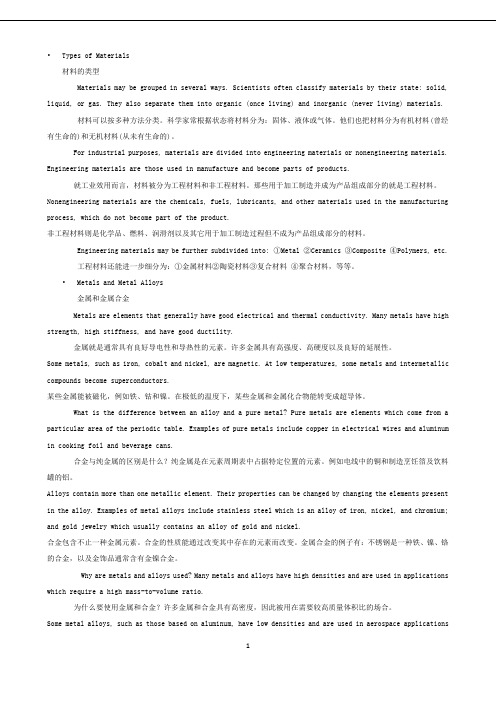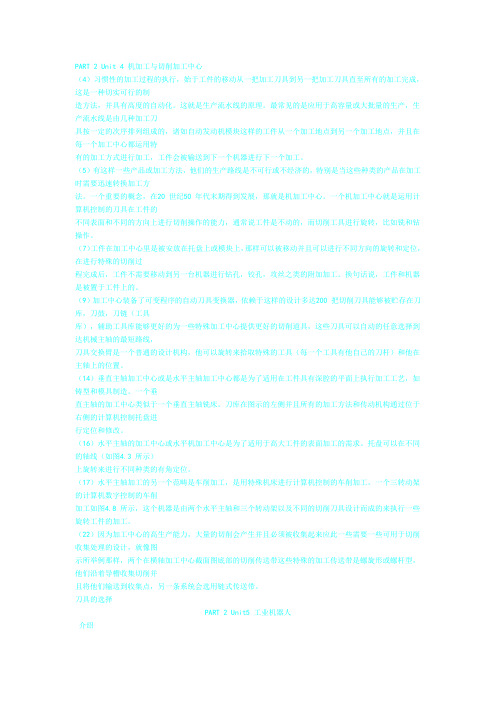机械工程英语 part2 unit3翻译
- 格式:doc
- 大小:822.50 KB
- 文档页数:12

Unit 1 材料的种类(1)材料的分类方法很多。
科学家常用的典型的方法是根据它们的状态分类:固体,液态或气态。
材料也分为有机(可再生)和无机材料(不可再生)。
(2)工业上,材料划分为工程材料或非工程材料。
工程材料用于制造和加工成零件的材料。
非工程材料是化学药品,燃料,润滑剂和其它用于制造又不用来加工成零件的材料。
(3)工程材料可进一步细分为:金属,陶瓷,复合材料,聚合材料,等。
Metals and Metal Alloys 金属和金属合金金属和金属合(4)金属有好的导电好导热性,很多金属有高的强度,高硬度和高的延展性。
象铁,钴,镍这些金属有磁性。
在非常低的温度下,一些金属和金属互化物变成超导体。
(5)合金和纯金属有什么区别?纯金属在元素周期表的特殊区域。
例如用于制造电线的铜和做锅和饮料罐的铝。
合金含有两种以上的金属元素。
改变金属元素的比例可以改变合金的性质。
例如,合金金属的不锈钢,是由铁,镍,和铬组成。
而黄金珠宝含有金镍合金。
(6)为什么要使用金属和合金?很多金属和合金有很高密度并用在要求质量与体积比高的的场合。
一些金属合金,象铝基合金,密度低,用在航空领域可以节省燃料。
很多合金有断裂韧度,可以承受冲击,且耐用。
金属有哪些重要属性?(7)【密度】质量除以体积叫做密度。
很多金属有相对高的密度,特别的,象聚合体。
高密度的材料常是原子量很大,象金或铅。
然而一些金属,像铝或镁密度低,就常常用在要求有金属特性而又要求低质量的场合。
(8)【断裂韧性】断裂韧度用来描述金属抗断裂的能力,特别的,当有裂纹时。
金属通常都有无关紧要的刻痕和凹坑,且有耐冲击性。
足球队员关注这一点当他确信面罩不会被击碎的时候。
(9)【塑形变形】塑性变形表述的是材料在断裂之前弯曲变形的能力。
作为工程师,我们通常设计材料使得能够在正常情况下不变形。
你不会想要一阵强烈的西风就把你的车刮得往东倾斜。
然而,有时,我们可以利用塑性变形。
汽车的承受极限就是在彻底破坏之前靠塑形变形来吸收能量。

机械工程英语a r t的完整翻译文档编制序号:[KK8UY-LL9IO69-TTO6M3-MTOL89-FTT688]《机械工程英语》PART2Unit11中央控制单元(CPU)的功能是控制所有系统部件的运行和对数据进行数字的或是逻辑的操作。
为了完成上述功能,CPU由以下两个单元组成2.控制单元3..数字逻辑单元3控制单元通过程序指令来协调大量的特种操作,这些操作包括接受输入计算机的数据,并决定和是以何种方法来处理这些数据。
控制单元能指挥数字逻辑单元的操作,他把数据发送给ALU来告诉ALU根据这些数据该运行什么功能,并且在哪里把结果存储下来。
控制单元完成上述操作的能力基于其安装了一个具有储存与记忆功能的总控程序机构。
4数字逻辑单元运行诸如加减比较之类的操作。
这些操作是根据数据以二进制的形式表现出来的。
在指示了确定的条件下,逻辑部也可以用来改变命令执行的次序。
此外,逻辑部分还具有编辑或清除数据等功能。
5控制单元和数字逻辑单元都是得用寄存器来完成他们的功能的,计算机寄存器是一个可以接收短暂存储,转移数据的小记忆装置。
根据计算机能力的不同,寄存器能建立出相应的字节数的字长。
每个词的字节数从4到64不等!PART2Unit2生产设备的数字控制(1)数控是程序控制的自动化,在数字控制系统中,设备通过数字,字母和符号来编码,以一种合适的格式为每一个特定的零件或工件定义一个程序指令集。
当工件变化时,程序也变化,改变程序的能力也就是适合中小批量生产。
写一个新程序比改变大量生产设备要容易的多。
(2)基本结构:数控系统由下面三部分组成:1.控制程序;2.机器控制单元;3.加工设备。
三部分的基本关系,由图2.1所示。
程序输入到控制单元由送入的程序来引导加工设备控制。
(3)指导程序是一步步详细的指导加工设备的指令。
通常指令把主轴上刀具相对于安装工具的工作台定位。
更多先进的说明包括主轴的转速,加工工具的选择及其功能。
程序刻在合适的介质中,提交到机器控制单元中,在过去几十年中,最常用的介质是一英寸宽的打孔纸带。

•Types of Materials材料的类型Materials may be grouped in several ways. Scientists often classify materials by their state: solid, liquid, or gas. They also separate them into organic (once living) and inorganic (never living) materials.材料可以按多种方法分类。
科学家常根据状态将材料分为:固体、液体或气体。
他们也把材料分为有机材料(曾经有生命的)和无机材料(从未有生命的)。
For industrial purposes, materials are divided into engineering materials or nonengineering materials. Engineering materials are those used in manufacture and become parts of products.就工业效用而言,材料被分为工程材料和非工程材料。
那些用于加工制造并成为产品组成部分的就是工程材料。
Nonengineering materials are the chemicals, fuels, lubricants, and other materials used in the manufacturing process, which do not become part of the product.非工程材料则是化学品、燃料、润滑剂以及其它用于加工制造过程但不成为产品组成部分的材料。
Engineering materials may be further subdivided into: ①Metal ②Ceramics ③Composite ④Polymers, etc.工程材料还能进一步细分为:①金属材料②陶瓷材料③复合材料④聚合材料,等等。

PART 2 Unit 4 机加工与切削加工中心(4)习惯性的加工过程的执行,始于工件的移动从一把加工刀具到另一把加工刀具直至所有的加工完成,这是一种切实可行的制造方法,并具有高度的自动化。
这就是生产流水线的原理。
最常见的是应用于高容量或大批量的生产,生产流水线是由几种加工刀具按一定的次序排列组成的,诸如自动发动机模块这样的工件从一个加工地点到另一个加工地点,并且在每一个加工中心都运用特有的加工方式进行加工,工件会被输送到下一个机器进行下一个加工。
(5)有这样一些产品或加工方法,他们的生产路线是不可行或不经济的,特别是当这些种类的产品在加工时需要迅速转换加工方法。
一个重要的概念,在20 世纪50 年代末期得到发展,那就是机加工中心。
一个机加工中心就是运用计算机控制的刀具在工件的不同表面和不同的方向上进行切削操作的能力,通常说工件是不动的,而切削工具进行旋转,比如铣和钻操作。
(7)工件在加工中心里是被安放在托盘上或模块上,那样可以被移动并且可以进行不同方向的旋转和定位,在进行特殊的切削过程完成后,工件不需要移动到另一台机器进行钻孔,铰孔,攻丝之类的附加加工。
换句话说,工件和机器是被置于工件上的。
(9)加工中心装备了可变程序的自动刀具变换器,依赖于这样的设计多达200 把切削刀具能够被贮存在刀库,刀鼓,刀链(工具库),辅助工具库能够更好的为一些特殊加工中心提供更好的切削道具,这些刀具可以自动的任意选择到达机械主轴的最短路线,刀具交换臂是一个普通的设计机构,他可以旋转来拾取特殊的工具(每一个工具有他自己的刀杆)和他在主轴上的位置。
(14)垂直主轴加工中心或是水平主轴加工中心都是为了适用在工件具有深腔的平面上执行加工工艺,如铸型和模具制造。
一个垂直主轴的加工中心类似于一个垂直主轴铣床。
刀库在图示的左侧并且所有的加工方法和传动机构通过位于右侧的计算机控制托盘进行定位和修改。
(16)水平主轴的加工中心或水平机加工中心是为了适用于高大工件的表面加工的需求。

机械工程英语第二版第二部分翻译Unit 1Introduction前言The central and essential ingredient of GAD/CAMis the digital computer.〔1〕Its inherent speed and storage capacity have made it possible to achieve the advances in image processing, real-time process control, and a multitude of other important functions that are simply too complex and time-consuming to perform manually. To understand CAD/CAM it is important to be familiar with the concepts and technology of the digital computerCAD/CAM的重要组成部分是数字计算机,它固有的速度以及存储能力似的它能够在图像处理,实时过程控制以及很多因太复杂太费时而人工无法完成的其他重要功能方面获得进步,要想懂得CAD/CAM,熟悉数字电脑的概念和技术是很重要的.The modern digital computer is an electronic machine that can perform mathematical and logical calculations and data processing functions in accordance with a predetermined program of instructions. The computer itself is referred to as hardware, whereas the various programs are referred to as software.现在数字计算机是一部能够根据预定的程序来完成数字和逻辑运算以及数据处理功能的电子设备,计算机本身称为硬件,而各种各样的程序称为软件There are three basic hardware components of a general-purpose digital computer; 一般用途的数字计算机由三种基本硬件组成.Central processing unit (CPU) 微处理器.Memory存储器.Input/output ( I/0 )section输入/输出设备The relationship of these three components is illustrated in Fig. 1.1. The central processing unit is often considered to consist of two subsections; a control unit and an arithmetic-logic unit (ALU). 这三个组成部分的关系如图1.1所示,中央处理器通常被认为包含两部分:一个控制器和一个运算器.The control unit coordinates the operations of all the other components. 控制器控制所有其他组成部分的运输。

2、应力和应变在任何工程结构中独立的部件或构件将承受来自于部件的使用状况或工作的外部环境的外力作用。
如果组件就处于平衡状态,由此而来的各种外力将会为零,但尽管如此,它们共同作用部件的载荷易于使部件变形同时在材料里面产生相应的内力。
有很多不同负载可以应用于构件的方式。
负荷根据相应时间的不同可分为:(a)静态负荷是一种在相对较短的时间内逐步达到平衡的应用载荷。
(b)持续负载是一种在很长一段时间为一个常数的载荷, 例如结构的重量。
这种类型的载荷以相同的方式作为一个静态负荷; 然而,对一些材料与温度和压力的条件下,短时间的载荷和长时间的载荷抵抗失效的能力可能是不同的。
(c)冲击载荷是一种快速载荷(一种能量载荷)。
振动通常导致一个冲击载荷, 一般平衡是不能建立的直到通过自然的阻尼力的作用使振动停止的时候。
(d)重复载荷是一种被应用和去除千万次的载荷。
(e)疲劳载荷或交变载荷是一种大小和设计随时间不断变化的载荷。
上面已经提到,作用于物体的外力与在材料里面产生的相应内力平衡。
因此,如果一个杆受到一个均匀的拉伸和压缩,也就是说, 一个力,均匀分布于一截面,那么产生的内力也均匀分布并且可以说杆是受到一个均匀的正常应力,应力被定义为应力==负载P /压力A,因此根据载荷的性质应力是可以压缩或拉伸的,并被度量为牛顿每平方米或它的倍数。
如果一个杆受到轴向载荷,即是应力,那么杆的长度会改变。
如果杆的初始长度L和改变量△L 已知,产生的应力定义如下:应力==改变长△L /初始长L因此应力是一个测量材料变形和无量纲的物理量,即它没有单位;它只是两个相同单位的物理量的比值。
一般来说,在实践中,在荷载作用下材料的延伸是非常小的, 测量的应力以*10-6的形式是方便的, 即微应变, 使用的符号也相应成为ue。
从某种意义上说,拉伸应力与应变被认为是正的。
压缩应力与应变被认为是负的。
因此负应力使长度减小。
当负载移除时,如果材料回复到初始的,无负载时的尺寸时,我们就说它是具有弹性的。
Lesson 1 力学的基本概念1、词汇:statics [stætiks] 静力学;dynamics动力学;constraint约束;magnetic [mæɡ'netik]有磁性的;external [eks'tə:nl] 外面的, 外部的;meshing啮合;follower从动件;magnitude ['mæɡnitju:d] 大小;intensity强度,应力;non-coincident [kəu'insidənt]不重合;parallel ['pærəlel]平行;intuitive 直观的;substance物质;proportional [prə'pɔ:ʃənəl]比例的;resist抵抗,对抗;celestial [si'lestjəl]天空的;product乘积;particle质点;elastic [i'læstik]弹性;deformed变形的;strain拉力;uniform全都相同的;velocity[vi'lɔsiti]速度;scalar['skeilə]标量;vector['vektə]矢量;displacement代替;momentum [məu'mentəm]动量;2、词组make up of由……组成;if not要不,不然;even through即使,纵然;Lesson 2 力和力的作用效果1、词汇:machine 机器;mechanism机构;movable活动的;given 规定的,给定的,已知的;perform执行;application 施用;produce引起,导致;stress压力;applied施加的;individual单独的;muscular ['mʌskjulə]]力臂;gravity[ɡrævti]重力;stretch伸展,拉紧,延伸;tensile[tensail]拉力;tension张力,拉力;squeeze挤;compressive 有压力的,压缩的;torsional扭转的;torque转矩;twist扭,转动;molecule [m likju:l]分子的;slide滑动; 滑行;slip滑,溜;one another 互相;shear剪切;independently独立地,自立地;beam梁;compress压;revolve (使)旋转;exert [iɡ'zə:t]用力,尽力,运用,发挥,施加;principle原则, 原理,准则,规范;spin使…旋转;screw螺丝钉;thread螺纹;2、词组a number of 许多;deal with 涉及,处理;result from由什么引起;prevent from阻止,防止;tends to 朝某个方向;in combination结合;fly apart飞散;3、译文:任何机器或机构的研究表明每一种机构都是由许多可动的零件组成。
PART 2 Unit 3数控编程数控编程由一系列方向构成,这些方向导致数控车床执行某种操作,加工是最常用的进程。
数控车床编程由内部编程部门来完成,在车间里,或者从外部源购买。
编程还可以手动或者在计算机辅助下来完成。
程序包括指令和命令。
几何指令涉及刀具和工件间的相对移动。
进程指令涉及主轴速度,进给以及道具等。
行动指令涉及插值的类型以及刀具或者工作台的缓慢和快速移动。
切换命令涉及到开/关冷却液供给状况,主轴旋转,主轴方向,换刀,工件进给,夹具固定等等。
(1)手工编程。
手工编程包括根据部分工程图纸首先算出刀具,工件以及工作台的尺寸关系,继而决定执行的操作和工序。
那么一个包括执行特定操作所需必要信息的程序表就准备好了,例如刀具切削,主轴转速,进给,切削深度,切削液,以及刀具或者工件间的相对位置或者移动。
根据这些信息,部分程序就准备好了。
通常一个纸带首先被准备好用于试用和调试程序。
根据纸带被使用多久,纸袋通常用更耐用的聚酯薄膜制成。
手工编程可以由那些具有特定制造工艺知识和能够理解,阅读以及更改部分程序的人来完成。
因为他们熟悉机床刀具和工艺流程,熟练的机械师可以做一些手工编程的编程培训。
然而,所涉及的工作是乏味的,费时的,因此不合算。
手工编程大多数用于简单的点对点应用上。
(2)计算机辅助编程。
计算机辅助编程是一种涉及到特殊符号的编程语言,这种语言可以决定角点的坐标,刀口以及工件的表面。
编程语言是与计算机通信的方式并且涉及到符号字符。
编程员用这种语言描述加工零件,而由计算机将零件程序转换为数控机床的执行指令。
许多种商业应用上的语言有多种多样的特点和应用。
第一种被使用的是类似于英语语句的语言,它在十九世纪五十年代末被开发出来并被称为APT语言。
这种语言,由于它多种多样的扩展形式,一直是最广泛的用于点对点和连续路径编程的语言。
复杂的工件现在使用基本的绘图进行制造,计算机辅助制造程序。
刀具的路径是在类似于一个CAD程序的大量的绘图环境下制造出来的。
机械工程专业英语第二版必考翻译(完整版)1.With low-power machinery or vehicles the operator can usually apply sufficient force through a simple mechanical linkage from the pedle or handle to the stationary part of the brake. In many cases, however, this force must be multiplied by using an elaborate braking system.(P5)用低能机器或传力工具,操作者通过向踏板或把手的一个简单机械连接构件作用足够的力量到车闸固定的部分。
大多数情况,然而,用一个详细(复杂)的车闸系统使这个力量成倍增加。
2. The fundamental principle involved is the use of pressed air acting through a piston in a cylinder to set block brakes on the wheels. The action is simultaneous on the wheels of all the cars in the train. The pressed air is carried through a strong hose from car to car with couplings between cars; its release to all the separate block brake units, at the same time, is controlled by the engineer. (Braking Systems)(P5)相关的基本原理是使用压缩气体,通过气缸内的活塞将闸块压在车轮起作用。
机械工程专业英语教程第一课:机械工程简介Introduction to Mechanical EngineeringSection 1: OverviewMechanical engineering is a diverse and dynamic field that encompasses the design, development, and operation of machinery, structures, and systems. This branch of engineering plays a crucial role in various industries, including automotive, aerospace, manufacturing, and energy.Section 2: Responsibilities and SkillsAs a mechanical engineer, your responsibilities will include designing and analyzing mechanical systems, conducting tests and experiments, and supervising the manufacturing process. You will also need to have a strong understanding of physics, mathematics, and computer-aided design (CAD). Additionally, problem-solving skills, attention to detail, and the ability to work well in teams are essential.Section 3: Career OpportunitiesA degree in mechanical engineering can open up a wide range of career opportunities. You could work in research and development, product design, manufacturing, or projectmanagement. Mechanical engineers are in demand in almost every industry, ensuring a stable and rewarding career path.Section 4: University CoursesTo become a mechanical engineer, it is essential to pursue a degree in mechanical engineering from a reputable university. The curriculum typically includes courses in engineering principles, materials science, thermodynamics, fluid mechanics, and mechanical design. Additionally, practical training through internships or cooperative education programs is crucial for gaining hands-on experience.Section 5: ConclusionMechanical engineering offers a challenging and rewarding career for those with a passion for solving problems and a desire to create innovative solutions. With the right education and skills, you can embark on a successful journey in the field of mechanical engineering. Remember, the possibilities are endless in this ever-evolving discipline.第二课:机械设计基础Fundamentals of Mechanical DesignSection 1: IntroductionIn this lesson, we will explore the fundamentals of mechanical design. Mechanical design involves the creation and development of physical systems and components that meet specific requirements and specifications. This processrequires a deep understanding of materials, mechanics, and engineering principles.Section 2: Design ProcessThe design process typically follows a systematic approach that includes several stages. These stages include problem identification, conceptual design, detailed design, manufacturing, and testing. Each stage involves various activities such as brainstorming, prototyping, and evaluation.Section 3: Design ConsiderationsDuring the design process, there are several important considerations to keep in mind. These include functionality, efficiency, reliability, safety, and cost-effectiveness. It is also crucial to consider the environmental impact and sustainability of the design.Section 4: Tools and SoftwareTo aid in the design process, engineers use various tools and software. Computer-aided design (CAD) software allows for precise modeling and simulation of mechanical systems. Finite element analysis (FEA) software helps in analyzing the structural integrity and performance of designs.Section 5: Case StudyTo further understand the application of mechanical design principles, we will examine a case study. This real-world example will demonstrate how the design process isimplemented to solve a specific problem and achieve desired outcomes.Section 6: ConclusionMechanical design is a critical aspect of mechanical engineering. It requires a combination of creativity, technical knowledge, and attention to detail. By mastering the fundamentals of mechanical design, you will be well-equippedto tackle complex challenges and contribute to the development of innovative solutions.以上是《机械工程专业英语教程》的课文翻译。